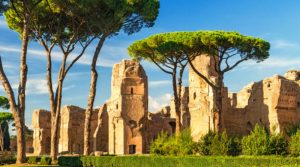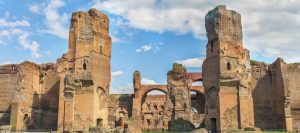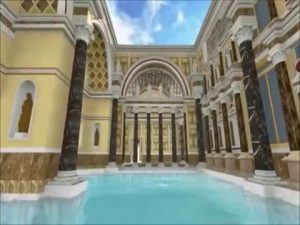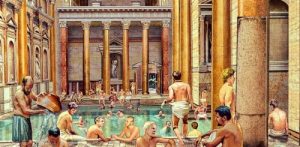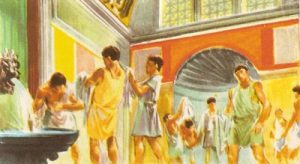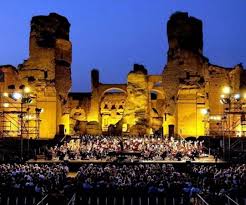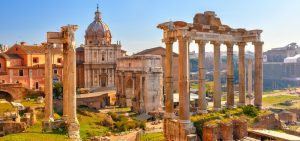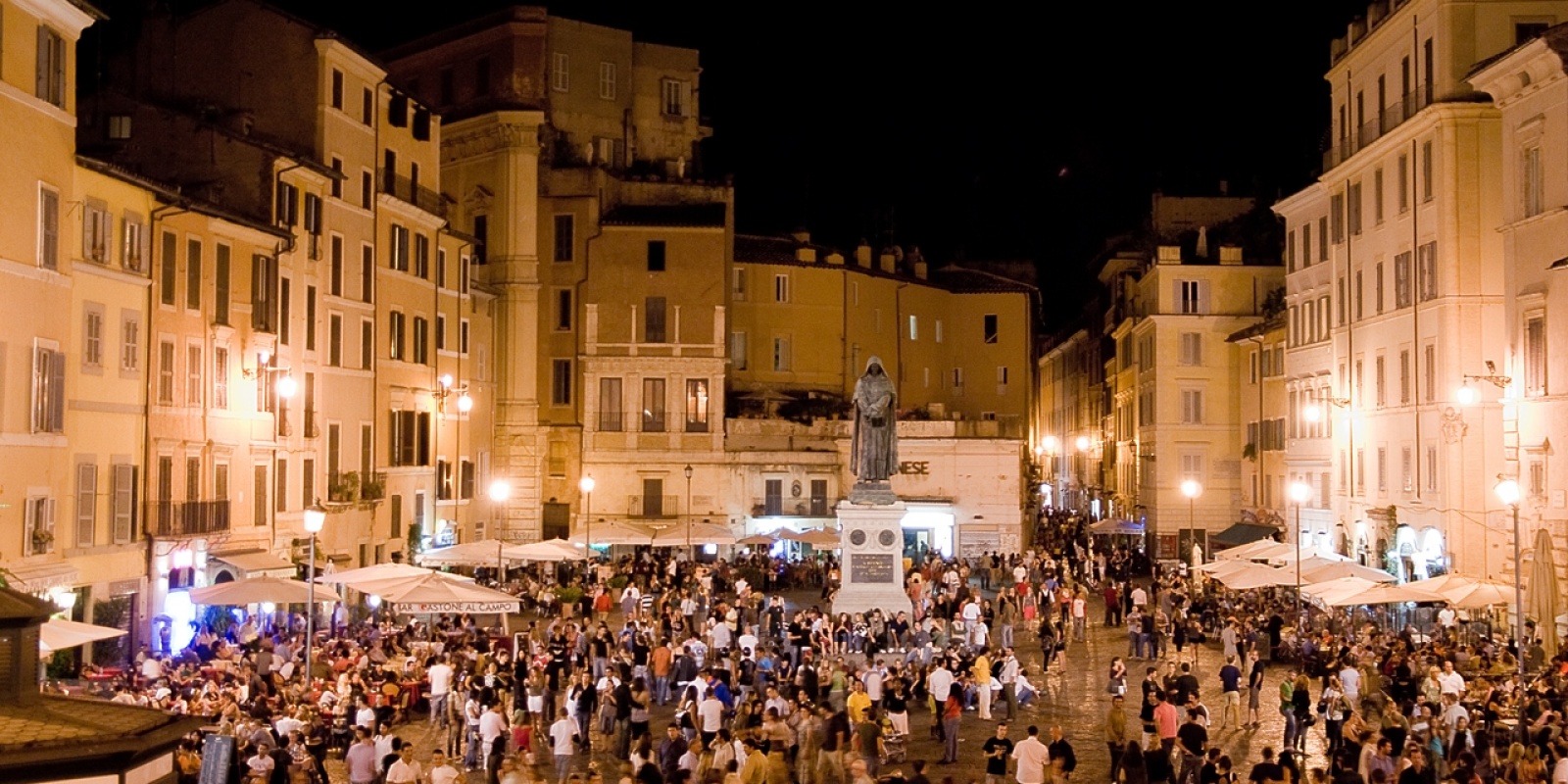Originally known as the Flavian Amphitheater, it was the largest building of the era.
Rome’s great gladiatorial arena is the most thrilling of the city’s ancient sights
and maybe is the main symbol of Rome.
It is an imposing construction that, with almost 2,000 years of history,
will bring you back in time to discover the way of life in the Roman Empire.
The Colosseum is located among three hills of Rome: the Palatine and Roman Forum valley on its South-western side, the last slopes of the Esquiline hill on the Northern side and the Celio on the Eastern side.
The emperor Vespasian originally commissioned the amphitheatre in AD 70-72 in the grounds of Nero’s vast Domus Aurea.
After that two-thirds of the city were destroyed by the great fire in 64 AD, emperor Nero used the valley between the three hills as a site for his new palace, the Domus Aurea (Golden House), which occupied an enormous area in the centre of the city. In the depression of the valley where now the Colosseum stands, Nero built an enormous rectangular artificial lake, that became part of a huge park provided with all sorts of amenities, including the most luxurious mansions, water sources and fountains.
Even after the decadent Roman emperor Nero took his own life in A.D. 68, his misrule and excesses fueled a series of civil wars. No fewer than four emperors took the throne in the tumultuous year after Nero’s death; the fourth, Vespasian, would end up ruling for 10 years (A.D. 69-79). The Flavian emperors, as Vespasian and his sons Titus (79-81) and Domitian (81-96) were known, attempted to tone down the excesses of the Roman court, restore Senate authority and promote public welfare. Vespasian wanted to gain popularity with the Roman citizens and to dissociate himself from Nero, the hated tyrant, showing that the times of tyranny and despotism were over. He made a point of giving back the area of Nero’s Domus Aurea to the Romans. The amphitheatre then – a public building donated by the emperor to the Roman citizens – stood on the former site of Nero’s mansion as a splendid symbol of the new political order.
Vespasian never lived to see it finished and it was completed by his son and successor Titus, a year after his death. The final stages of construction of the Colosseum were completed under the reign of Titus’ brother and successor, Domitian.
To mark its inauguration, Titus held games that lasted 100 days and nights, during which some 5000 animals were slaughtered.
The arena’s official name is Flavian Amphitheatre, the name Colosseum dates back to the XI century, and it is origin is uncertain. The most popular version is that the name comes from a colossal statue of Nero, called indeed Colossus Neronis, that at first was in the Domus Aurea. The statue was one of the most visible (and arrogant) features of Nero’s residence: a 36 meter (120 ft) bronze statue of Nero placed just outside the entrance. This monstrosity was built in imitation of the Colossus of Rhodes, one of the Seven Wonders of the Ancient World. The Colossus was later dedicated by Vespasian to the Sun God – after replacing its face – and then affixed with the heads of several emperors, until Hadrian moved it near the amphitheatre.
Another theory maintains that the name might have come from the Collis Iseum, a nearby hill where a temple dedicated to Isis once stood.
]]>
Visit the Baths of Caracalla with us
The Baths of Caracalla, located by ancient Appian Way in Rome, were named after the emperor Caracalla (whose official name was Marcus Aurelius Antoninus, hence the original name of the baths, Thermae Antoninianae) who reigned from A.D. 211-217. His father Septimius Severus commissioned the baths and after his death the project was completed by his son Caracalla in 216 A.D.
The emperor was nicknamed Caracalla for a Gallic tunic he used to wear, but this name was never officially used. Caracalla is infamous for killing his more popular brother Geta. He is also known for his decision to offer citizenship to all free inhabitants of the Roman Empire, mainly to increase the income from taxes.
Caracalla’s distant cousin and successor Heliogabalus (218-222) erected the side-buildings, but it was not until the time of Severus Alexander (222-235) that the finishing touches were put on the structure.
The ruins of these baths are enormous and very well preserved with many mosaics still partially intact.
It was the largest bath complex in the world: the central building of the complex is circa 215 by 115 meters and consisted of four levels, two above ground and two below. It is not difficult to be impressed by it even today: the imposing ruins are still thirty meters high.
Beside the bathhouse, the complex was home to shops, an athletic track, sports fields, pleasure gardens, massage rooms, saunas, two reading rooms, perfumeries, music pavilions.
In addition to all of this, one of the side-buildings housed an underground temple to Mithras.
Much of the art that was found on the walls and some mosaic floors have been removed and taken to various museums. The interior of the building was enormously rich in color. The marble walls were littered with paintings and mosaics, the floors were also mosaics and painted sculpture adorned many if not all the alcoves. The structure endorsed 6300m3 of marble and employed 600 marble workers and 6,000 tradesmen to labor on this one project. It is said that before his death Septimius Severus issued 13, 000 prisoners of war from his campaigns to work at Baths building. 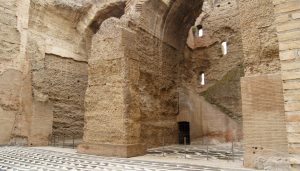
What the baths meant for romans
At a time, when Rome’s crowded tenements had few sanitary facilities, the more than fifty public baths in Imperial Rome played an important part in Roman society. Not only did it improve the cleanliness and health of its citizens, but the thermae were also places where Romans came to socialize, gossip and relax. Like most grand baths, the Baths of Caracalla were about more than just swimming and bathing. It was basically an ancient Roman community center, with wo palaetra (gyms), two libraries (one for Greek texts, one for Latin texts), and plenty of shops.
In their heyday, the Baths of Caracalla could accomodate a staggering 1,600 bathers at a time. In total the baths welcomed between 6,000 and 8,000 visitors each day.
They were fed by a dedicated acquaduct. A complex water distribution system ensured a constant flow of water from the Aqua Marcia aqueduct. Below the main buildings were two levels, the upper one was used for services and heating the water, the lower one was used for water drainage.
The ritual of bathing was a long process, starting with a hot bath in the calidarium. Next up was the lukewarm tepidarium, followed by the cold frigidarium. Then followed a swim in the natatio, an open air swimming pool. The walls and floor of both the tepidarium and calidarium were heated by a system called the hypocaust. The floor was raised and spaces were left between the walls to allow for hot air from a massive furnace to circulate through. In the subterranean structures, hundreds of stokers burned ten tons of wood every day to keep the water at the right temperature. The delivery of fuel was such an important task that Severus Alexander counted it among his personal responsibilities.
The end of the baths
The baths were extremely popular, and remained in use until the sixth century—even the first few waves of barbarian invaders and rulers loved them. The barbarians known as the Ostrogoths, though, not so much. They destroyed the hydraulics and heating systems, and the baths ceased to function in AD 537.
The complex was, as were most ancient structures, subsequently looted over the centuries—you’ve probably seen some of its sculptures without realizing they originally came from here, including the Belvedere Torso, now in the Vatican Museums, and the famous Farnese Bull and Farnese Hercules, both now in the Naples Archological Museum.
Later, the complex was mined for its very stones,which made excellent pre-cut building materials to help construct medieval Rome.
The Bath of Caracalla, excellent location for shows
The Baths of Caracalla are now the site of summertime open-air performances of ballet and opera, including works that employ spectacularly large casts, such as Giuseppe Verdi’s Aida and Georges Bizet’s Carmen. During the summer time, the Caracalla baths turn into a platform for breath taking cultural sets: the fancy Teatro dell’ Opera love to held the most famous operas for all the Roman- and non Roman.
Underground Museum
In December 2012 a museum opened in the tunnels underneath the Baths of Caracalla. The network of tunnels, four kilometers long, was created to service the baths above. The furnaces to heat the hot water baths stood here and the tunnels also served as storage space.
The six-meter-wide tunnels create an atmospheric background for the display of objects that were found on site such as large sculpted capitals, marble reliefs and other ornaments that once decorated the sumptuous bath complex.
There’s no place like Rome. The rich tapestry of ancient history, monuments, emotional people, and iconic food formulates the ideal destination for anyone with a thirst for world culture.
There are relics of old worshipped gods scattered across the city, cafe bars through which both the young and old pass briefly for an espresso and the latest gossip, a rush of waiters laying out tables on the pavement before the lunchtime rush, and too much traffic on the road.
Rome is every stereotype you’ve ever heard and more – and I wouldn’t have it any other way.
Equally as predictable in Rome are the attractions that people want to see, and the cool things they want to do.
Everyone wants to see the Colosseum, the Pantheon, and St. Peters; and for good reason too as they’re all exceptional things to see. Each one will leave your jaw more open than the last – but surely there’s something less predictable to do?
You will love for sure to get off-the-path for a little while to uncover alternative, local, and unique things to do in every city. With Rome there has never been any exception either. We will make sure that you can visit also places that may not just entertain you but also be great or unusual enough to amaze you.
Whilst you’re preparing for your own trip to the Italian capital I hope we will have the chance to show you an unusual aspect of the city that you’ve (hopefully) not been suggested before.
]]>Visit Campo de Fiori with us
The square known as Campo de’ Fiori was once a meadow, and, during the Ancient times, it was located between the Pompey’s Theater and the Tiber River.
Because the river was prone to flooding, the area was undeveloped for many centuries.
The piazza as we see today only began to take shape during the fifteenth century, under Pope Callistus III who decided to pave it on 1456, as several important buildings had already been constructed in the area, including the Orsini Palace and the Palazzo della Cancelleria. The Campo de’ Fiori became a very popular part of Rome frequented by the most influential historical figures. Its popularity drew new businesses to the area, opening workshops, inns and taverns making this neighborhood one of the most prosperous of the city.
For centuries public executions took place at Campo de’ Fiori. Criminals and so-called heretics were often tortured and executed here. Many were burned at the stake while others were hanged. One of the more well-known figures executed on this square was the Italian philosopher Giordano Bruno, who in the year 1600 was burned at the stake by the Roman Inquisition because the ideas he spoke of were “dangerous”. The Dominican friar was one of the first to realize that stars are actually suns in the universe. In 1887, sculptor and freemason Ettore Ferrari designed a statue of Bruno. It was placed in the piazza, facing the Vatican as if in defiance of all it stands for. Bruno is now considered an advocate and martyr of the right to free speech.
Today the square is much more peaceful than during the Middle Ages. The Campo de’ Fiori is currently one of the most beloved parts of the city. Since 1869, every morning from Monday through Saturday it houses a market well-known for its flowers and fruit and vegetable. After the sunsets, the area becomes one of the best meeting places in Rome thanks to its wide variety of restaurants, cocktail bars and terraces. There are probably more craft workshops and restorers’ studios, as well as family-run neighbourhood stores, than in any other part of the city.
Campo de’ Fiori is for sure one of the places to visit in Rome
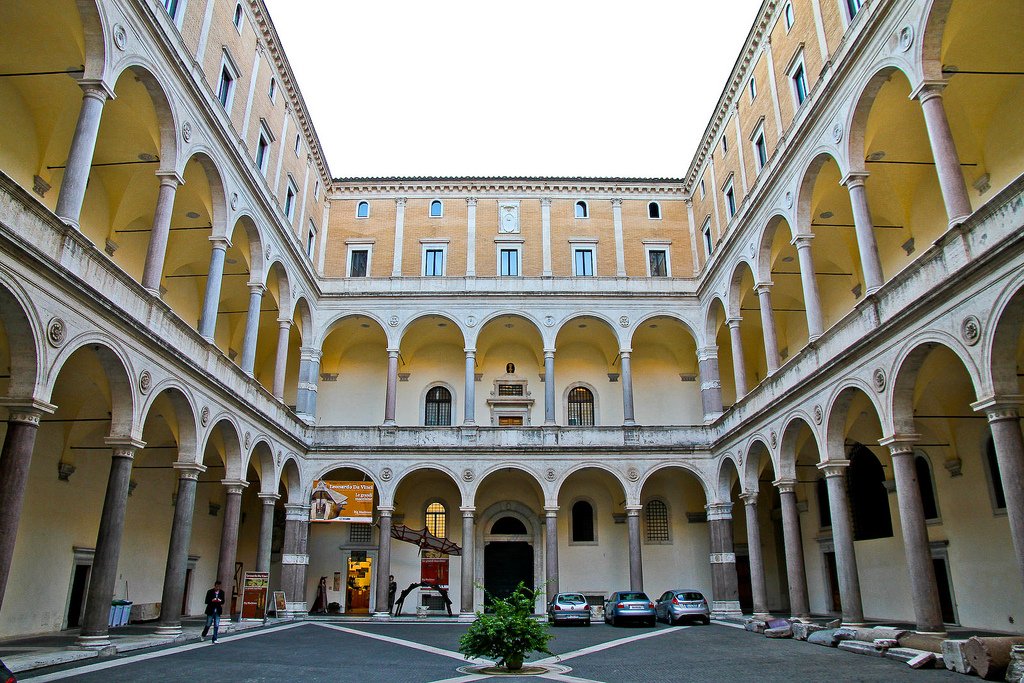
Palazzo della Cancelleria
This building, which is a World Heritage Site and is attributed to Bramante, was once the papal chancery and still belongs to the Holy See. It now houses the Romana Rota, the highest ecclesiastical appeal tribunal of the Roman Catholic church. A permanent exhibition of replicas of many of Leonardo Da Vinci’s machines and designs is open to the public.
Palazzo Farnese
Currently the home of the French embassy to Italy, Palazzo Farnese is one of the most important high Renaissance palaces in Rome. Artists such as Giacomo Della Porta, Michelangelo, da Sangallo and Vignola all left their mark on the majestic palace whose Carracci gallery has recently been restored. Behind Palazzo Farnese runs the quaint Via Giulia. Ivy lined, this road is pleasant to walk down to avoid the noise and crowds while taking in Rome’s elegance. There are many beautiful palazzi with imposing doors and housing expensive antique shops.
Fontana della Terrina
In 1590 a fountain was erected on Campo de’ Fiori to provide the neighborhood with fresh water supplied by a branch of the Aqua Virgo aqueduct. The fountain was designed by Giacomo della Porta. Due to its resemblance to a terrine it later became known as the Fontana della Terrina. At the end of the nineteenth century the fountain had to make way for the monument to Giordano Bruno. In 1925 it was moved to the piazza in front of the Chiesa Nuovo where it still stands today. Around the same time a copy of the fountain was made for the Campo de’ Fiori. The fountain, which occupies a spot on the west side of the square, is almost identical to the original except that this one does not have a lid on it, hence it looks more like a bowl than a terrine.
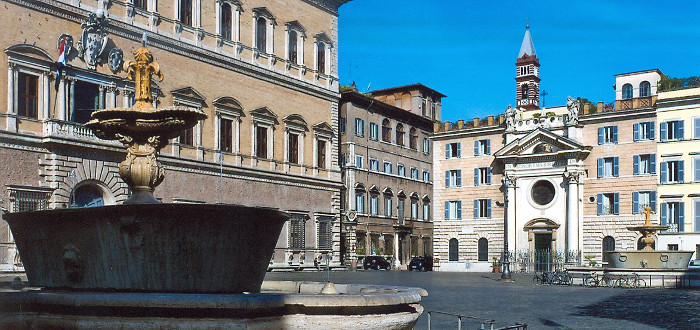
]]>
Visit the Tiber Island with us
Many Romans believe that you are not a true “Roman” unless you were born on the Tiber island: the Fatebenefratelli hospital has been curing the sick and delivering little Roman babies for over 500 years
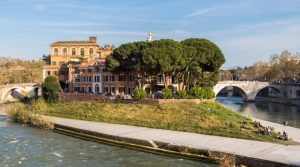
The Tiber Island has always been a place of mystery, wrapped in legend, surrounded by the river and forever tied to the origins of Rome. Since prehistoric times, the island has been the easiest point of crossing the river towards the commercial roads to the north and south of Rome and it was certainly not by chance that the first and most ancient of the city’s river ports was born right in front of it. This singular piece of land in the middle of the Tiber River was called by the Romans “between two bridges”. In fact, the island was connected to the mainland by the Cestium bridge on one side and by the Fabricium bridge (called also the Bridge of the Jews for its proximity to the Hebrew Ghetto) on the other.
There was a terrible legend having to do with this second bridge: there are four marble heads per side on the mainland end. It was said that they were the heads of four architects hired by the pope Sixtus V for the restoration of the island and that, since they were evidently not in total agreement with the Pope, at the restoration’s end —they were decapitated! At any rate, there are eight marble heads and they come down to us from the Roman era. The gruesome anecdote is probably due to the pontiffs fame as a “head-chopper” because of his heavy hand in regards to the repression of crime. The Tiber Island has extremely old origins that can be sifted from the numerous legends regarding its beginnings: apparently it was built on the ruins of an ancient ship, the shape of which it still retains. The Romans, to give more credence to the story, built a stone bow and stern, giving it the look of a warship —with an obelisk in the middle for a mast!
The presence of hospitals on the island is tied to another ancient legend; the historian Livius wrote that, because of a terrible plague that had befallen the city, the Romans traveled all the way to Epidaurus, in Greece to ask the oracle there how to stop the epidemic. The priests at the largest sanctuary of the god of medicine, Aesculapius, gave the Roman ambassadors a sacred serpent. Returning home, just as the ship was pulling into the port of the Tiber, the snake jumped ship, swam to the island and disappeared into the thick vegetation.
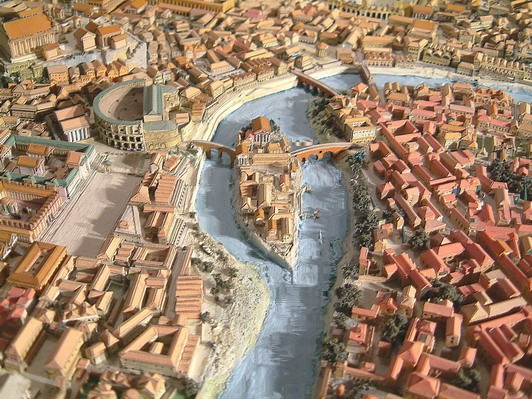
A temple was dedicated to Aesculapius on the island: it had a pit full of snakes sacred to the god, that were fed by the priests. So it was that the island was consecrated to the god of medicine and since that time has been famous as a place of hospitals and healing. Actually, the island was an excellent place for the purpose because it offered guaranteed isolation from the rest of the community; in fact, during the plague of the 1600s, the entire island was transformed into a quarantine hospital. In the year 1000, in place of the temple of Aesculapius, the church of Saint Bartholomew was built, although it now has a Baroque façade. Next to the temple there was a portico where a rather particular therapy was practiced, the “incubatio”: this consisted of keeping the sick out in the cold and without food for several days so that they should be purified. The poor souls then had to recount their dreams to the priests who would duly diagnose: a sort of rudimental form of psychoanalysis. As for its efficacy…well, we’ll probably never know.
The Romans built another two temples on the island: one was dedicated to Faunus, who protected women giving birth. Even today, the hospital on the island is well-known for its excellent maternity ward.
In line with the island’s ancient vocation, during the Middle Ages, a structure was created to serve pilgrims, the poor and the sick, and later became a hospital that still functions to this day. Its name, “Fatebenefratelli”—which means “do well or do good, brothers”- seems to come from the singsong sort of mantra that the friar-doctors of the hospital would repeat continuously as they moved through the streets. Over the years the “Fatebenefratelli” improved the precarious and unhealthy conditions in which they had found the hospital and it was they who took care of restoring the second church on the island, that of Saint John Calibita. On the façade of the church there’s a copy of a fresco of the Madonna of the Lamp, protagonist in two miraculous events; it seems that the flame of the lamp in question, when submersed by the flooding Tiber, refused to go out and later, the Madonna was seen weeping just before Napoleon’s invasion of Italy!
The island is also famous for what remains of a legendary bridge, Ponte Emilio, better known by the Romans as “Broken Bridge”: it was actually Rome’s very first stone bridge, restored and repaired several times due to damage caused by the turbulent Tiber but the river finally got the better of it, leaving only the few surviving remains we see today. Life in the the middle of the Tiber wasn’t always easy, particularly because of the frequent periodic floods that have been part of Rome’s history for more than 2600 years. Strolling through the center you may notice plaques on many of the houses that record the extraordinary levels reached by the flood waters. Sometimes the Tiber flooded more than 17 meters high inside the city, often arriving right in the center of town, forcing people to get around in boats! 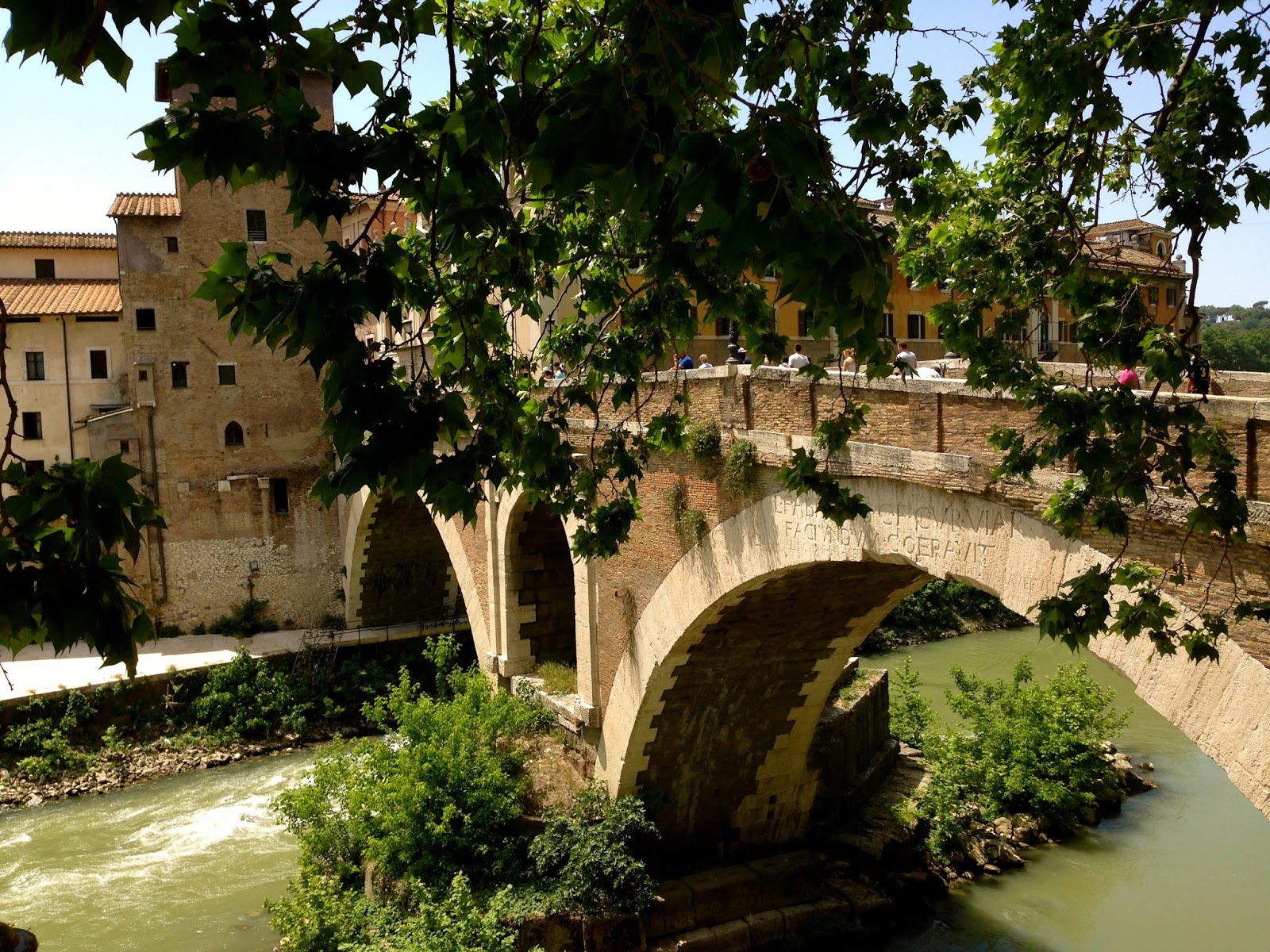 The hospital on the Tiber Island was many times on the verge of being submerged but not everyone knows that the portholes that close the windows on the first floor are watertight and flood-proof! It was in 1870, after one of the most disastrous floods, that the decision was made to build up the banks of the Tiber with the high walls of travertine we see today. If, on the one hand, they have helped avoid further flood damage, on the other, they inevitably changed the face of Rome and its relationship with the river.
The hospital on the Tiber Island was many times on the verge of being submerged but not everyone knows that the portholes that close the windows on the first floor are watertight and flood-proof! It was in 1870, after one of the most disastrous floods, that the decision was made to build up the banks of the Tiber with the high walls of travertine we see today. If, on the one hand, they have helped avoid further flood damage, on the other, they inevitably changed the face of Rome and its relationship with the river.
Someone actually proposed to flatten out the Tiber Island to widen the riverbed. Fortunately, the extravagant idea never took hold and the island is still there, a picturesque place of care and healing, romantic walks and a privileged viewpoint to observe the blond Tiber up close.
]]>
Visit Piazza del Campidoglio with us
THE PIAZZA DEL CAMPIDOGLIO DESIGNED BY MICHELANGELO BUONARROTI
 The piazza came about because Charles V, Holy Roman Emperor, organized a visit to Rome in 1536. Pope Paul III was so dismayed by the state of the sodden Capitoline Hill that he commissioned Michelangelo to design a square. Michelangelo wanted the square to face St Peter’s Basilica, the political centre of Rome, instead of the Roman Forum. He also proposed the construction of another palace, Palazzo Nuovo, which would face Palazzo dei Conservatori. This palace, in its turn, would have a new façade. The Palazzo Senatorio’s front would also be redesigned so that all the buildings and the square would work harmoniously.
The piazza came about because Charles V, Holy Roman Emperor, organized a visit to Rome in 1536. Pope Paul III was so dismayed by the state of the sodden Capitoline Hill that he commissioned Michelangelo to design a square. Michelangelo wanted the square to face St Peter’s Basilica, the political centre of Rome, instead of the Roman Forum. He also proposed the construction of another palace, Palazzo Nuovo, which would face Palazzo dei Conservatori. This palace, in its turn, would have a new façade. The Palazzo Senatorio’s front would also be redesigned so that all the buildings and the square would work harmoniously.
The execution of the plans took so long that Michelangelo didn’t live to see his work completed. Nevertheless, his designs were followed meticulously and finished several centuries later.
The Piazza del Campidoglio is one of the most beautiful squares in Rome, attracting millions of visitors every year. Its popularity is also due to its proximity to the Capitoline Museums and the legendary sculpture of the Capitoline Wolf, situated between the Palazzo Senatorio and Palazzo Nuovo. The bronze she-wolf on top of the column is a replica. The original is housed in the Capitoline Museums. An imposing bronze equestrian statue of Marcus Aurelius was erected in the centre of the square. It is currently housed in the Palazzo dei Conservatori and in the square stands a replica of the  Roman Emperor instead.
Roman Emperor instead.
Visit the Capitoline Hill with us
The Capitoline Hill in Ancient Rome
Excavations of the hill have uncovered traces of a settlement that was built here in the Iron Age. The hill was an ideal site for the early settlers since it was situated right near a ford across the Tiber and its steep rocky slopes provided a natural protection against enemies. The hill had two summits: the Arx to the north and the lower but larger Capitolium to the south. The area in between was called the Asylum. It was a place where refugees from other states could find shelter.
The Capitoline Hill in Ancient Times
Even before the Republican era Rome’s kings built massive temples on the Capitoline Hill. They came to symbolizeRome’s position as Caput Mundi, which literally means ‘head of the world’.
The largest and most impressive of these temples was the Temple of Jupiter Optimus Maximus Capitolinus. The gilded temple was the most important sanctuary in ancient Rome. It was built in the sixth century BC on the Capitolium summit (now the site of the Palazzo dei Conservatori) by Tarquinius Priscus, the first Etruscan king of Rome. It measured 53 by 63 meters and was dedicated to three gods: Jupiter Optimus Maximus, Juno Regina and Minerva. There was a separate cella for
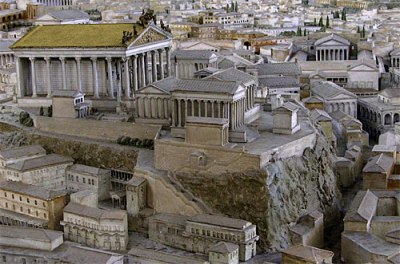
each god. The temple was decorated with reliefs and large terracotta statues. The statue of Jupiter was later replaced by a version in gold and ivory.
According to legend the Tarpeian Rock, situated just south of the Temple of Jupiter, was named after a Roman woman called Tarpeia, who helped the Sabines conquer the Capitoline Hill during the reign of Romulus, the legendary founder of Rome. Tarpeia was promised jewelry for her treason but the Sabines instead crushed here between their shields. From then on traitors of Rome were thrown from this rock.
The north summit, the Arx, was long the site of Rome’s fortress. In 344-343 BC a temple was built here on the order of the city’s military leader Marcus Furius Camillus. The temple was dedicated to the goddess Juno. There are several legends that explain the name Moneta, which is possibly derived from the Latin word monere, meaning warn or advise. According to one version people heard voices from the temple that warned them of an earthquake. Another version tells us the name stems from the geese that warned Camillus when Gauls tried to capture the Capitoline Hill. The mint of Rome stood ‘ad monetam’ – near the Temple of Juno Moneta – hence the word moneta, which gave its name to the word money.
The Tabularium, which housed the state archives, was built between the Temple of Jupiter and the Temple of Juno. It was a large building with several colonnaded stories that looked out over the Forum Romanum. From the Forum you can still clearly see the remains of the lower floor of the Tabularium, now situated below the Palazzo Senatorio.
The Middle Ages
During the exile of the popes in Avignon Rome became depopulated and the Capitoline Hill was even used as a goat pasture, which gave it the name Monte Caprino (goat mountain). By the sixteenth century the Renaissance brought a revival of Rome’s grandeur and with it a complete redesign of its heart, the Capitoline Hill. In 1536 Michelangelo drew up plans for a new square between the two hilltops, the Piazza del Campidoglio
The Capitoline Hill Today
Today only traces of the ancient temples are visible. Instead a huge nineteenth century monument built for Italy’s first king dominates the north slope.
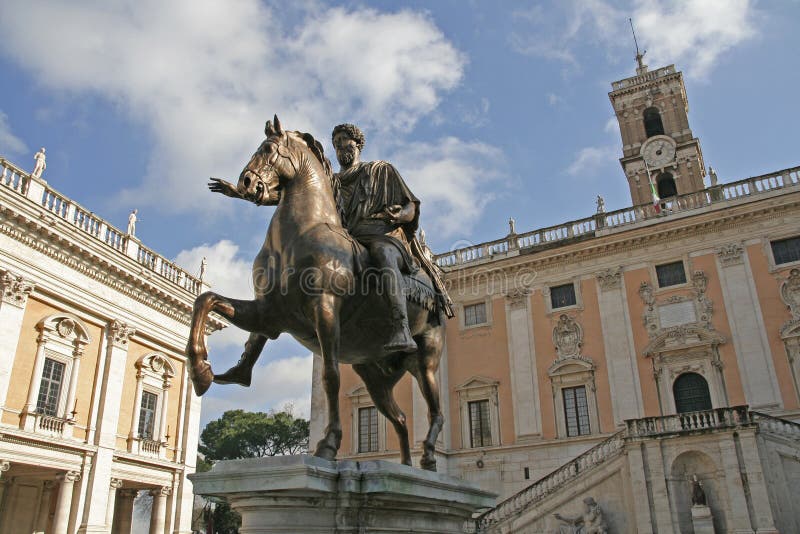 As impressive as this monument may be, the highlight of the Capitoline Hill however is now undoubtedly the beautiful Piazza del Campidoglio, masterfully designed by Michelangelo. It can be reached from the foot of the hill by ascending the majestic Cordonata stairs. The square is bordered by three palazzos, all with facades designed by Michelangelo. The central one is the Palazzo Senatorio, the city hall of Rome, which was built on top of the ancient Tabularium. The other two, the Palazzo dei Conservatori and Palazzo Nuovo, are home to the Capitoline Museums. From the Piazza del Campidoglio you can walk straight to the Victor Emmanuel II Monument. This massive monument, which is also known as Il Vittoriano, was built in the early twentieth century and honors Italy’s first king. During the construction of the monument, many historic buildings on the hill were demolished. Near the Piazza del Campidoglio, at the site of the ancient Temple of Juno is the Santa Maria in Aracoeli, a church with a history that goes back to the sixth century. A large staircase with 122 (when starting on the right) to 124 (starting on the left) steps lead to the church on top of the Capitoline Hill.
As impressive as this monument may be, the highlight of the Capitoline Hill however is now undoubtedly the beautiful Piazza del Campidoglio, masterfully designed by Michelangelo. It can be reached from the foot of the hill by ascending the majestic Cordonata stairs. The square is bordered by three palazzos, all with facades designed by Michelangelo. The central one is the Palazzo Senatorio, the city hall of Rome, which was built on top of the ancient Tabularium. The other two, the Palazzo dei Conservatori and Palazzo Nuovo, are home to the Capitoline Museums. From the Piazza del Campidoglio you can walk straight to the Victor Emmanuel II Monument. This massive monument, which is also known as Il Vittoriano, was built in the early twentieth century and honors Italy’s first king. During the construction of the monument, many historic buildings on the hill were demolished. Near the Piazza del Campidoglio, at the site of the ancient Temple of Juno is the Santa Maria in Aracoeli, a church with a history that goes back to the sixth century. A large staircase with 122 (when starting on the right) to 124 (starting on the left) steps lead to the church on top of the Capitoline Hill.
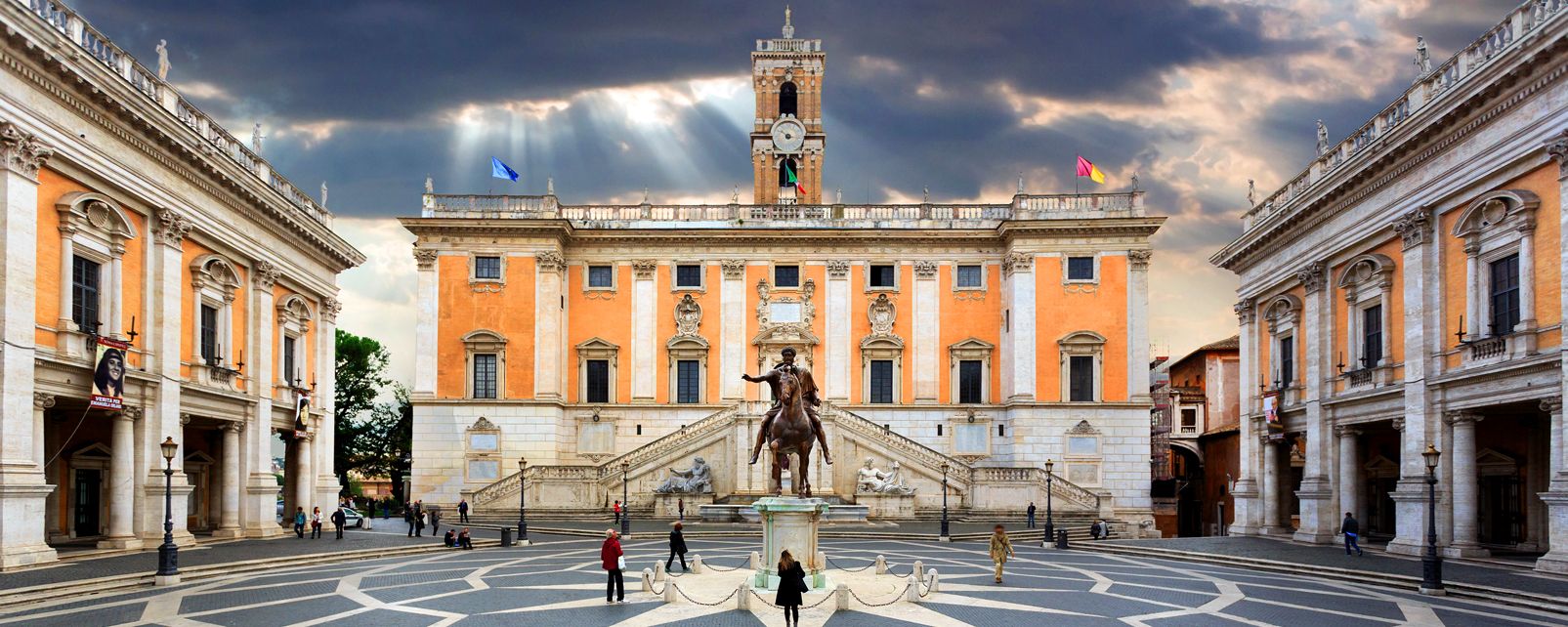
]]>
Visit the Jewish Ghetto with us
The history of Jews in Rome follows all the drastic twists and horrifying turns that have shaped the experience of the Jewish diaspora across the world. Rome has one of the oldest, continually surviving Jewish communities outside the Holy Land. The first ghetto was the Venetian ghetto, formed in 1516, while Rome’s was the world’s second, established in 1555 and its borders were laid down in a Papal Bull along with various discriminatory laws about what professions Jews could and could not hold. The land chosen for Roman ghetto was among the worst in the city. Since the Tiber regularly flooded, the lower parts of the ghetto were regularly underwater. The Jewish Ghetto was walled-in and crowded and life was grim until the Ghetto walls were torn down in 1888.
Jewish culture grew and thrived in the Roman Ghetto, but the neighborhood also witnessed one of the most heart-wrenching episodes of the Nazi occupation during the Second World War. After the German government proclaimed that Rome’s Jews would be spared deportation to the concentration camps if a gold ransom was paid, many in the city, including The Vatican, donated their gold. Even though the Jewish community raised the required amount, Nazi soldiers entered the neighborhood on October 16th, 1943 and deported between 1,000 and 2,000 people. Only 16 survived.
Situated just across from the Tiber Island on the east bank of the river, today the area is a haven of tranquillity in the 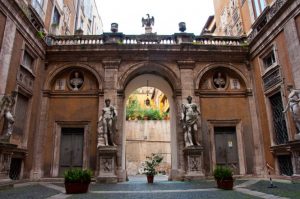 traffic maelstrom that is Rome. Over the years the area has grown into a beautiful neighborhood filled with restaurants, churches, and synagogues that combine jewish culture with the grandeur of Roman architecture. The ruins of the enormous ancient Portico, the Portico d’Ottavia, rise from under 20 feet below street level, at once a testament to history as well as the changes time brings.
traffic maelstrom that is Rome. Over the years the area has grown into a beautiful neighborhood filled with restaurants, churches, and synagogues that combine jewish culture with the grandeur of Roman architecture. The ruins of the enormous ancient Portico, the Portico d’Ottavia, rise from under 20 feet below street level, at once a testament to history as well as the changes time brings.
There are lots of different cool things to do and see – an ancient market and theatre, an impressive synagogue, a lot of tasty restaurants (artichokes!), a postcard perfect fountain and much much more. So, we’ve compiled the following neighborhood bucket list for you to tick off when you visit the Rome Jewish Ghetto.
Teatro Marcello
Named after Marcus Marcellus, Emperor Augustus’s nephew, who died five years before its completion, the Teatro was begun by Julius Caesar and completed by Augustus in 13 BC. It’s also known as the Jewish Coliseum for its resemblance to the original Colosseum. This ancient, open-air theater once held approximately 11,000 to 20,000 spectators, and the seats filled for acting, dancing or singing performances. Today it still holds different shows throughout the summer.
The Great Synagogue
The Great Synagogue of Rome, or the Tempio Maggiore di Romain Italian, is the largest synagogue in all of Rome and possibly all of
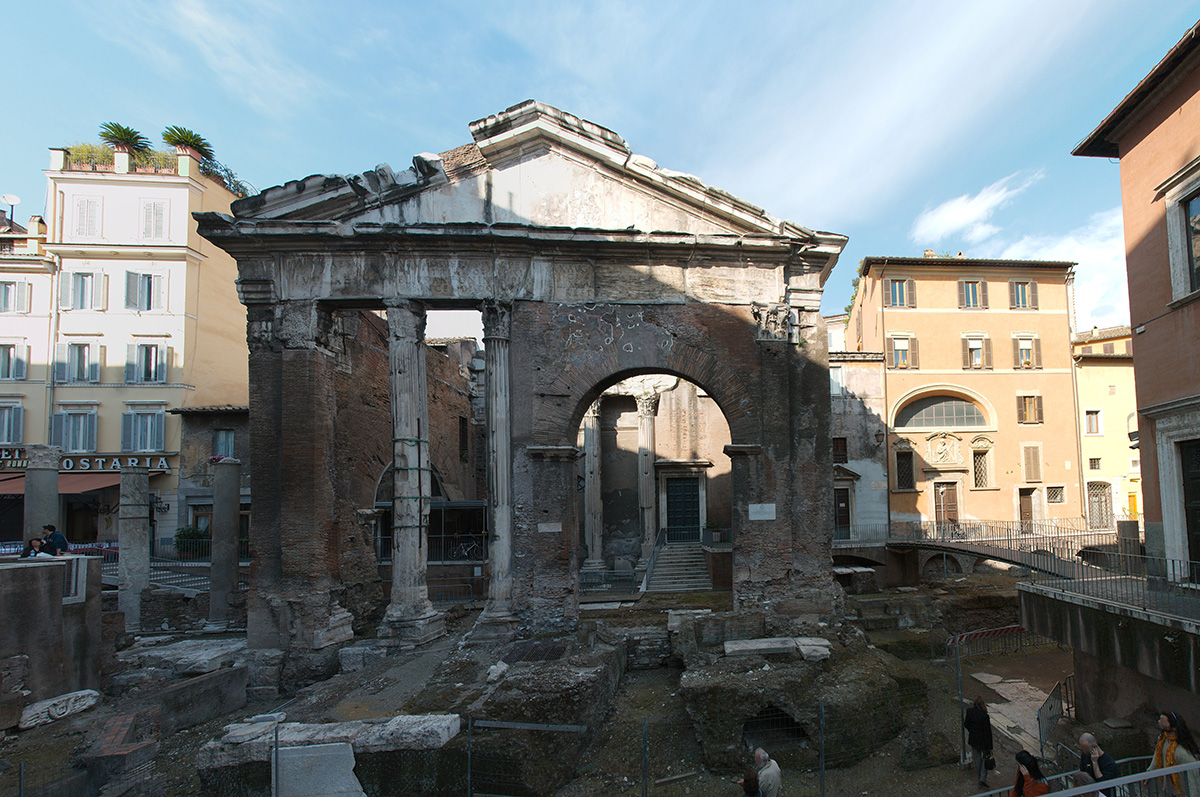
Italy. This impressive building is pretty new by Roman standards. After people of Jewish faith were granted citizenship during Italian unification in 1870, the original ghetto synagogue was torn down and plans for the Great Synagogue began. The cornerstone was laid in 1901 and the Synagogue was officially completed in 1904, a veritable baby in the Roman skyline.
Jewish Museum of Rome
The Jewish Museum is located in the Great Synagogue. Opened underneath the Great Synagogue in 1960, it displays silverware and textiles, parchments and marble carvings from the collections of the Jewish Community of Rome. It tells the history of the Jews and the Jewish G
hetto in Rome.
The Fontane delle Tartarughe
The Turtle Fountain is a late Renaissance fountain. Though it might have been called the Dolphin Fountain, as it once had dolphins where the turtles now sit, they were removed because of low water pressure, and the turtles were added to make the fountain seem complete. Originally built as a drinking fountain, the water was sourced from the Acqua Vergine, one of Rome’s first aqueducts – a big deal for sixth century Romans!
]]>
Visit the Basilica with us
Historical information
 Pope Sisto III (Pope from 432 to 440 AD) made it build to dedicate it to the Holy Mary, after the deliberation of the Concilium of Ephesus, in 431 AD; the Basilica was built on a previous building, a Roman house from the Imperial Age, according to the remains found.
Pope Sisto III (Pope from 432 to 440 AD) made it build to dedicate it to the Holy Mary, after the deliberation of the Concilium of Ephesus, in 431 AD; the Basilica was built on a previous building, a Roman house from the Imperial Age, according to the remains found.
Regardless its origin, the Pope ordered the building of 42 panels about the Bible stories, still present in the central navy, together with the Triumph Arch, representing the most important stories about the art of the empire. Niccolò IV enlarged it, ordering the reconstruction of the apsis, the decoration by mosaics and the building of New facade, decorated by Filippo Risuti mosaics. After the 15th century and the realization of the panelled ceiling, by Giuliano Di Sangallo – it was made of gold from America and from the famous “reyes catolicos” Ferdinando D’Aragona and Isabella di Castiglia.
The current facade of the Basilica is from 1743, ordered by Benedetto XIV to Ferdinando Fuga. Even if these decorations covered the previous mosaics, they have unconsciously preserved them by the age and the damages of the time. The last reconstruction we know about is the creation of a holy door on the right, decorated by bronze reliefs about the Incarnation stories, from 1937. It is important to know that the Basilica di Santa Maria Maggiore has other two names “Sancta Maria ad Praesepe” ( as there are some remains of the Bethlehem cave, such as Jesus manger), and “Sancta Maria ad Nives” or “Santa Maria della Neve”. The latter is a very funny name so that historians don’t trust its origins.

The Legend
4th August 352 AD, Rome.
It’s night but somebody is not sleeping in the Eternal City. It is Pope Liberio, because he is dreaming about the mother of the Saviour. She has a very particular message for him, a premonition: on the following day, a very unusual event would have taken place and the Pope had to order the built of a church dedicated to her.
4th August 352 AD, Rome
It’s still night in the Eternal City, and there’s somebody else is not sleeping: now the subject we are talking about is completely different. It is an old and rich Roman patrician couple, Giovanni and his wife. A woman wearing a blue dress tells them about a mysterious event and she orders them to build a church dedicated to her.
If those people were simple Roman patricians of the previous centuries, the vision of the Holy Mary would have been useless, because they would have been pagans. But we are not talking about the ages of Augusto, Nerone and Commodo. A lot of people were converting them-selves to the Catholic religion. Giovanni and his wife were these type of people. They decided to donate their richness to create a temple dedicated to the Holy Mary and the only one problem was the choice of the place where to build it, and how to do it.
5th August 352 AD, Rome, Esquilino Hill.
It’s a sunny morning, it seems it’s summer and people feel very hot. Summer is hot obviously, it is not so strange, but what is strange is it is snowing on August. As they hear about tho  se news, Pope Liberio and the couple go to the Esquilino Hill, thinking about the vision they had during the previous night. They feel very excited thinking about the woman they dreamt about, and they get touched observing the miracle around them, and thinking about the ways God finds to act. They realise the snow is the best symbol of purity God could choose. So they immediately decide to build the basilica and they start to draw the perimeter of the walls on the snow. This is the story of the Basilica di Santa Maria Maggiore, according to the legend of course.
se news, Pope Liberio and the couple go to the Esquilino Hill, thinking about the vision they had during the previous night. They feel very excited thinking about the woman they dreamt about, and they get touched observing the miracle around them, and thinking about the ways God finds to act. They realise the snow is the best symbol of purity God could choose. So they immediately decide to build the basilica and they start to draw the perimeter of the walls on the snow. This is the story of the Basilica di Santa Maria Maggiore, according to the legend of course.
Snow on August; myth, art and reality
Obviously it is just a legend, even if without imagination we probably wouldn’t have so precious works of art, such as the apsis describing Pope Liberio designing the Basilica and the masterpiece by Masolino Da Panicale.
